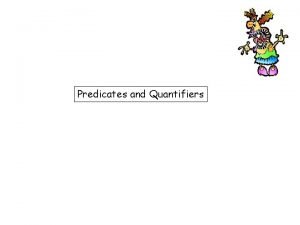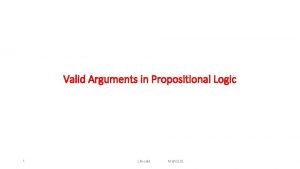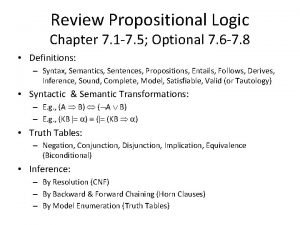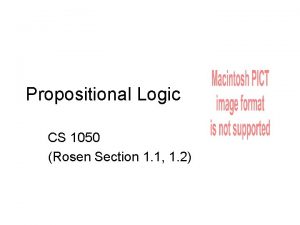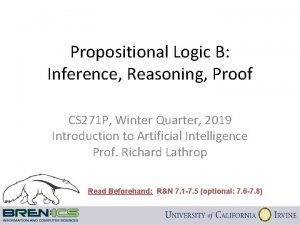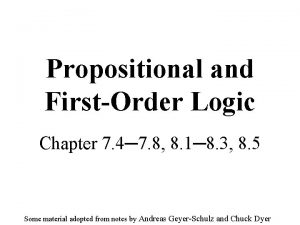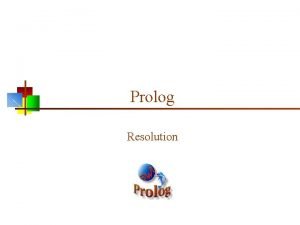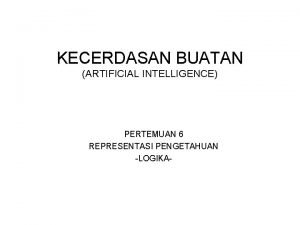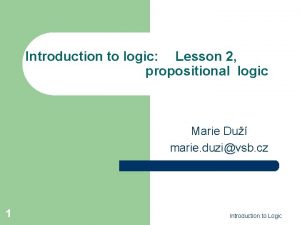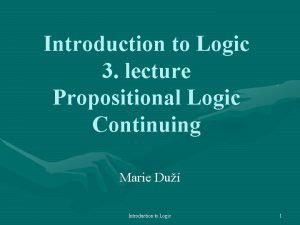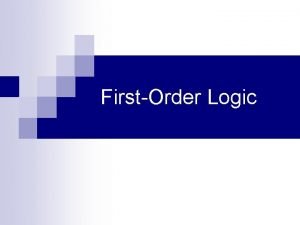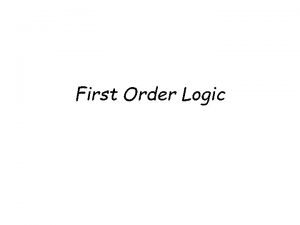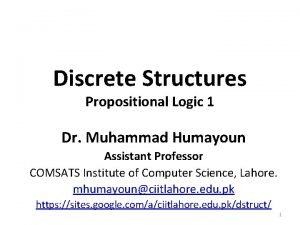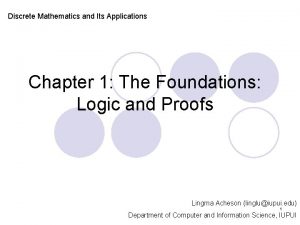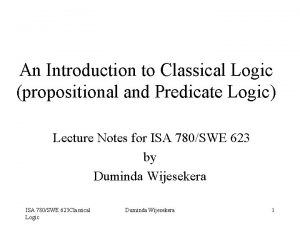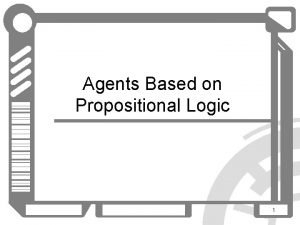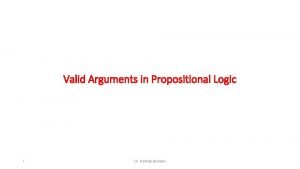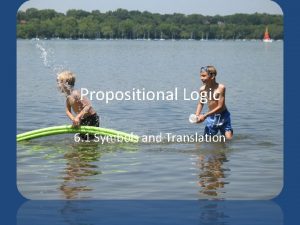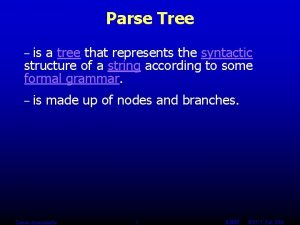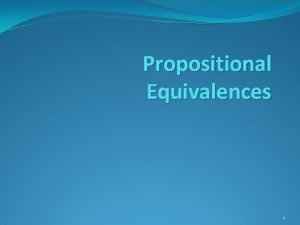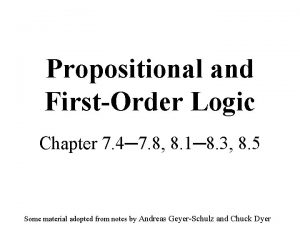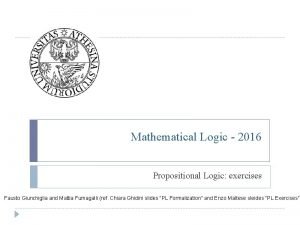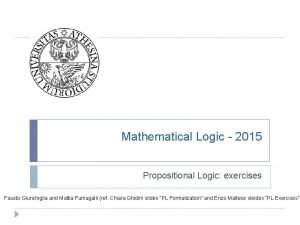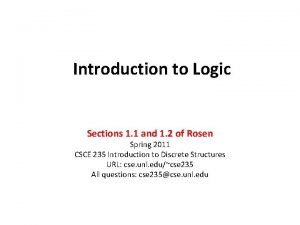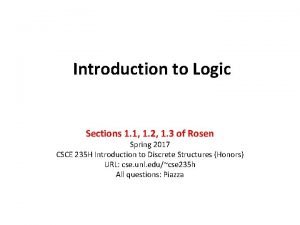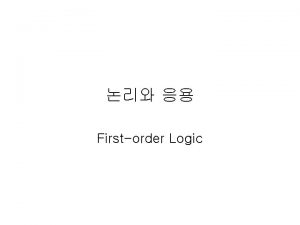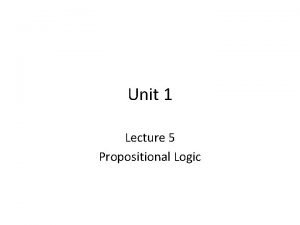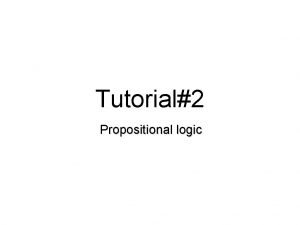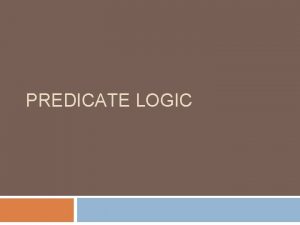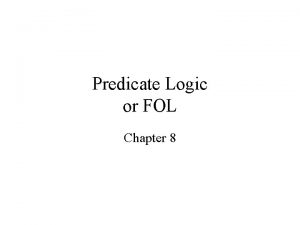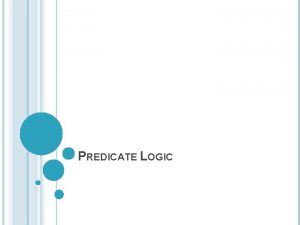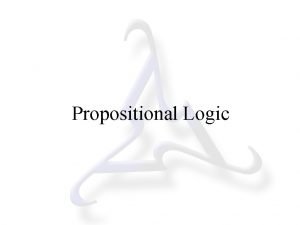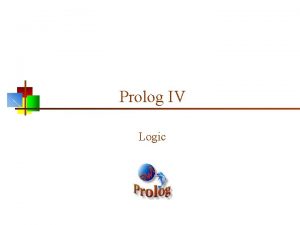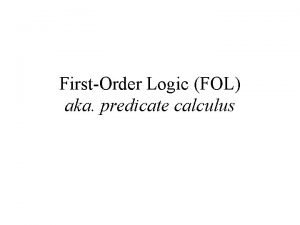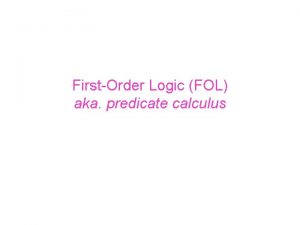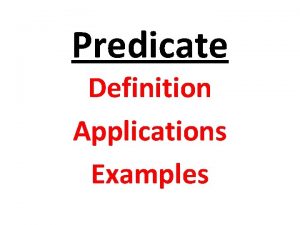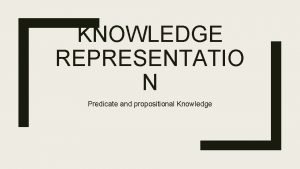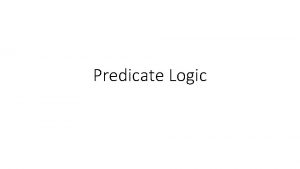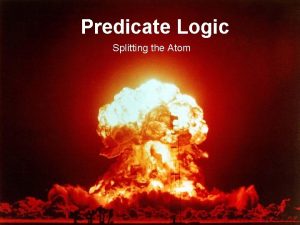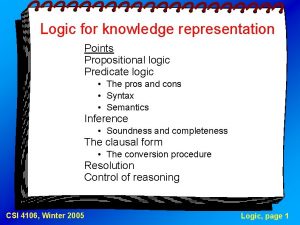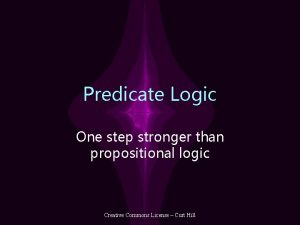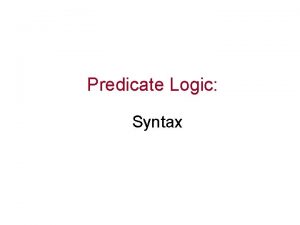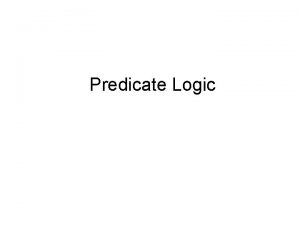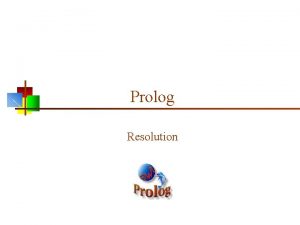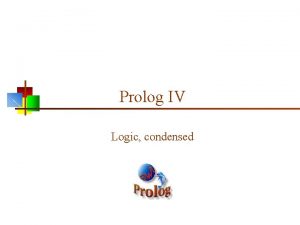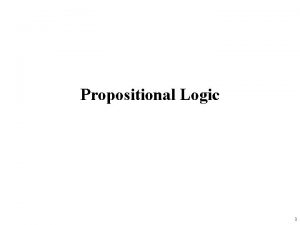Predicate Logic or FOL Chapter 8 Propositional Logic


































- Slides: 34

Predicate Logic or FOL Chapter 8

Propositional Logic can’t say • If X is married to Y, then Y is married to X. • If X is west of Y, and Y is west of Z, then X is west of Z. • And a million other simple things. • Fix: – extend representation: add predicates – Extend operator(resolution): add unification

Syntax • See text formal rules. • All of propositional + quantifiers, predicates, functions, and constants. • Variables can take on values of constants or terms. • Term = reference to object • Variables not allowed to be predicates. – E. G. What is the relationship between Bill and Hillary? • Text Notation: variables lower case, constants upper • Prolog Notation: variables are upper case, etc

Term • A term with no variables is a ground term. • Composite Objection: function of terms or primitives – Convenience: we don’t want to name all objects – e. g. nounphrase(det(the), adj(tall), noun(tree)). – E. g. left. Leg(John). – Successor of 1 may be s(1), but we write 2. – Successor of 2 s(s(1)), but we write 3.

Goldbach’s Conjecture • For all n, if integer(n), even(n), greater(n, 2) then there exists p 1, p 2, integer(p 1), integer(p 2), prime(p 1), prime(p 2), and equals(n, sum(p 1, p 2)). • Quantifiers: for all, there exists • Predicates: integer, greater, prime, even, equals. • Constants: 2 • Functions: sum.

Semantics • Validity = true in every model and every interpretation. • Interpretation = mapping of constants, predicates, functions into objects, relations, and functions. • For Goldbach wrt to standard integer model: interpretation = mapping n to an even integer. (Context).

Representing World in FOL • All kings are persons. goes to? • for all x, King(x) & Person(x). • for all x, King(x) => Person(x).

Representing World in FOL • All kings are persons. • for all x, King(x) => Person(x). OK. • for all x, King(x) & Person(x). Not OK. – this says every object is a king and a person. • In Prolog: person(X) : - king(X). • Everyone Likes icecream. • for all x, Likes(x, icecream).

Negating Quantifiers • ~ there exist x, P(x) • ~ for all x, P(x) For all x, Likes(x, Icecream) No one likes liver. For all x, not Likes(x, Liver) • For all x, ~P(x) • There exists x, ~P(x) • There does not exist an x, not Likes(x, Icecream) • Not there exists x, Iikes(x, Liver).

More Translations • Everyone loves someone. • There is someone that everyone loves. • Everyone loves their father. • See text. • For all x, there is a y(x) such that Loves(x, y(x)). • There is an M such that for all x, Loves(x, M). • M is skolem constant • For all x, Loves(x, Father(x)). • Father(x) is skolem function.

Unification • If p and q are logical expressions, then Unify(p, q) = Substitution List S if using S makes p and q identical or fail. • Standardize apart: before unifying, make sure that p and q contain different variable names.

Most General Unifier (MGU) • f(X, g(Y)) unifies with f(g(Z), U) with substitutions {X/g(a), Y/b, U/g(b), Z/b}. • But also if {X/g(Z), U/g(Y)}. • The MGU is unique up to renaming of variables. • All other unifiers are unify with the MGU. • Use Prolog with = for unification.

Occurs Checking • When unifying a variable against a complex term, the complex term should not contain the same variable, else non-match. • Prolog doesn’t check this. • Ex. f(X, X) and f(Y, g(Y)) should not unify.

Modeling with Definite Clauses: at most one positive literal 1. It is a crime for an american to sell weapons to a hostile country. 1’. American(x)&Weapons(y)&Hostile(z) & Sell(x, y, z) => Criminal (x). 2. The country Nono has some missiles. There exists x Owns(Nono, x)&Missile(x). 2’. Missile(M 1). … Skolem Constant introduction 2’’. Owns(Nono, M 1).

Prove: West is a criminal 3. All of its missiles where sold to it by Colonel West. 3’. Missile(x)&Owns(Nono, x) => Sells(West, x, Nono). 4’. Missile(x) => Weapon(x). . . “common sense” 5’. Enemy(x, America) => Hostile(x). 6’. American(West). 7’. Enemy(Nono, American).

Forward Chaining • Start with facts and apply rules until no new facts appear. Apply means use substitutions. • Iteration 1: using facts. • Missile(M 1), American(West), Owns(Nono, M 1), Enemy(Nono, America) • Derive: Hostile(Nono), Weapon(M 1), Sells(West, M 1, Nono). • Next Iteration: Criminal(West). • Forward chaining ok if few facts and rules, but it is undirected.

Resolution gives forward chaining • Enemy(x, America) =>Hostile(x) • Enemy(Nono, America) • |- Hostile(Nono) • Not Enemy(x, America) or Hostile(x) • Enemy(Nono, America) • Resolve by {x/Nono} • To Hostile(Nono)

Backward Chaining • Start with goal, Criminal(West) and set up subgoals. This ends when all subgoals are validated. • Iteration 1: subgoals American(x), Weapons(y) and Hostile(z). • Etc. Eventually all subgoals unify with facts.

Resolution yeilds Backward Chaining • A(x) &W(y)&H(z)& S(x, y, z) =>C(x) • -A(x) or –W(y) or –H(z) or –S(x, y, z) or C(x). • Add goal –C(West). • Yields –A(West) or -W(y) or –H(z) or -S(West, y, z). Etc.

Resolution is non-directional • Both a power (inference representation) and a weakness (no guidance in search) • -a or –b or –c or d or e equals • a, b, c =>d or e and • a, b, c, -d => e etc. • Prolog forces directionality and results in an incomplete theorem prover.

FOL -> Conjuctive Normal Form • • • Similar to process for propositional logic, but Use negations rules for quantifiers Standarize variables apart Universal quantification is implicit. Skolemization: introduction of constants and functions to remove existential quantifiers.

Skolemization • Introduction of constants or functions when removing existential quantifier. • There exists an x such that P(x) becomes: P(A) for some new constant symbol A. • Everyone has someone who loves him • For all x, Loves(F(x), x) where F(x) is a new function.

Resolution in CNF • Just like propositional case, but now complimentary first order literals unify. • Theorem (skipping proof): FOL with resolution is refutation complete, i. e. if S is a set of unsatisfiable clauses, then a contradiction arises after a finite number of resolutions. • Let’s take in on faith!

Results • Proof of theorems in: – Lattice Theory – Group theory – Logic • But didn’t generate theorem. • Lenat’s phd thesis AM generated mathematical theorems, but none of interest.

Limitations • 2 nd order: What is the relationship between Bush and Clinton? • Brittle: If knowledge base has contradiction, then anything derivable. (false |= P) • Scaleability – Expensive to compute – Difficult to write down large number of statements that are logically correct. • Changing World (monotoncity): what was true, is not longer. • Likelihoods: What is likelihood that patient has appendicitis given high temp. • Combining Evidence

Situation Calculus/Planning • The world changes and actions change it. • What to do? • Early approach: Define Actions via: – Preconditions : conjunctions of predicates – Effects: changes to world if operator applied – Delete conditions: predicates to delete – Add conditions: predicates to add

Blocks World Example • Action: Move(b, x, y)…move b from x to y • Preconditions: – On(b, x)&Clear(y)&Block(b)& Clear(b) – Careful: and b = y else problems ( b to b) • Postconditions: – On(b, y) & Clear(x) & not On(b, x) & not Clear(y) • Similar for other operators/actions. • Now search: better plan searchers possible.

More Extensions • Special axioms for time, space, events, processes, beliefs, goals • Try to do any simple story, e. g. Goldilocks and three bears. • How would you know you did it? • Problems: – Represent what’s in story – Represent what’s not in story but relevant. – Inferencing

Time • Before (x, y) implies After(y, x) • After(x, y) imples Before(y, x) • Before(x, y) and Before(y, z) implies Before(x, z) etc. • When are you done? • What about during?

Space and more • In(x, y) and In(y, z) implies in(x, z). • Infront, behind, etc • Frame problem: you turn, some predicates change and some don’t. • etc. And lots more: heat, wind, hitting, physical objects versus thoughts, knowing,

Example Questions • • Was Goldilocks hungry? Was Goldilocks tired? Why did the bed break? Could the baby bear say “Papa, don’t talk unless you are spoken too”.

Expert Systems: Engineering Approach • We can keep the representation language of FOL, but do not adopt the semantics. • Attach to each fact and rule a belief (#) • Provide an ad hoc calculus for combining beliefs. • Now multiple proofs valuable since they will add evidence. • This worked, if domain picked carefully. The hard part: getting the rules or knowledge.

Mycin: by Shortliffe 1976 • First rule based system that performed better than average physician at blood disease diagnosis. • Required 500+ rules that were painful to capture. (Knowledge Acquisition) • Used ad hoc calculus to combine “confidences” in rules and facts.

Soy. Bean Disease Diagnosis • Expert diagnostician built a rule-based expert system for the task. • System worked, but not as good as he was. • Some knowledge was not captured. • Using Machine Learning, rules were create from a large data base. • The ML rules did better than the expert rules, but did not perform as well as the expert.
 First order logic vs propositional logic
First order logic vs propositional logic First order logic vs propositional logic
First order logic vs propositional logic Third order logic
Third order logic How a predicate function become a propositional function?
How a predicate function become a propositional function? Valid arguments in propositional logic
Valid arguments in propositional logic Propositional logic examples
Propositional logic examples Xor in propositional logic
Xor in propositional logic Xor in propositional logic
Xor in propositional logic Propositional logic notation
Propositional logic notation Implies in propositional logic
Implies in propositional logic Prolog propositional logic
Prolog propositional logic Propotional logic dapat digunakan untuk..
Propotional logic dapat digunakan untuk.. Tense logic
Tense logic Propositional logic notation
Propositional logic notation Pros and cons of propositional logic
Pros and cons of propositional logic Xor in propositional logic
Xor in propositional logic Discrete math propositional logic
Discrete math propositional logic Application of propositional logic
Application of propositional logic Mathematical system
Mathematical system Xor in propositional logic
Xor in propositional logic Conjunction elimination
Conjunction elimination Agents based on propositional logic
Agents based on propositional logic Valid arguments in propositional logic
Valid arguments in propositional logic Propositional logic symbols and translation
Propositional logic symbols and translation Parse tree propositional logic
Parse tree propositional logic Tautology contingency or contradiction
Tautology contingency or contradiction Horn clause
Horn clause Propositional logic exercises
Propositional logic exercises Propositional logic exercises
Propositional logic exercises Proposition and not proposition
Proposition and not proposition Logic in mathematics
Logic in mathematics Propositional logic
Propositional logic Aima ai slides
Aima ai slides Simple proposition
Simple proposition Propositional logic examples and solutions
Propositional logic examples and solutions



